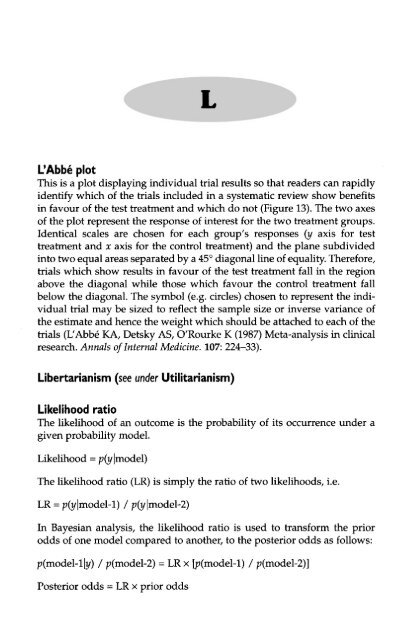Dictionary of Evidence-based Medicine.pdf
Dictionary of Evidence-based Medicine.pdf
Dictionary of Evidence-based Medicine.pdf
Create successful ePaper yourself
Turn your PDF publications into a flip-book with our unique Google optimized e-Paper software.
L<br />
L'Abbe plot<br />
This is a plot displaying individual trial results so that readers can rapidly<br />
identify which <strong>of</strong> the trials included in a systematic review show benefits<br />
in favour <strong>of</strong> the test treatment and which do not (Figure 13). The two axes<br />
<strong>of</strong> the plot represent the response <strong>of</strong> interest for the two treatment groups.<br />
Identical scales are chosen for each group's responses (y axis for test<br />
treatment and x axis for the control treatment) and the plane subdivided<br />
into two equal areas separated by a 45° diagonal line <strong>of</strong> equality. Therefore,<br />
trials which show results in favour <strong>of</strong> the test treatment fall in the region<br />
above the diagonal while those which favour the control treatment fall<br />
below the diagonal. The symbol (e.g. circles) chosen to represent the individual<br />
trial may be sized to reflect the sample size or inverse variance <strong>of</strong><br />
the estimate and hence the weight which should be attached to each <strong>of</strong> the<br />
trials (L'Abbe KA, Detsky AS, O'Rourke K (1987) Meta-analysis in clinical<br />
research. Annals <strong>of</strong> Internal <strong>Medicine</strong>. 107: 224-33).<br />
Libertarianism (see under Utilitarianism)<br />
Likelihood ratio<br />
The likelihood <strong>of</strong> an outcome is the probability <strong>of</strong> its occurrence under a<br />
given probability model.<br />
Likelihood = p(y|model)<br />
The likelihood ratio (LR) is simply the ratio <strong>of</strong> two likelihoods, i.e.<br />
LR = p(y|model-l) / p(y|model-2)<br />
In Bayesian analysis, the likelihood ratio is used to transform the prior<br />
odds <strong>of</strong> one model compared to another, to the posterior odds as follows:<br />
p(model-l|i/) / p(model-2) = LR x [p(model-l) / p(model-2)]<br />
Posterior odds = LR x prior odds










